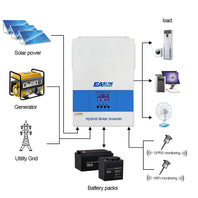When it comes to harnessing solar energy for off-grid or grid-tied systems, the choice of solar charge controller plays a crucial role in optimizing power output and battery health. Two popular types of solar charge controllers are MPPT (Maximum Power Point Tracking) and PWM (Pulse Width Modulation). Understanding the differences between these two technologies is essential for making an informed decision when setting up a solar power system.
The Basics of MPPT and PWM
MPPT and PWM solar charge controllers are both designed to regulate the flow of energy from solar panels to batteries. However, they employ different methods to achieve this goal. PWM controllers work by slowly reducing the amount of power sent to the battery as it reaches full capacity, while MPPT controllers use a more sophisticated algorithm to continuously track and adjust the operating point to extract maximum power from the solar panels.
For instance, when a solar panel has an output of 17 volts and the battery is at 12 volts, a PWM controller will reduce the voltage to 12 volts and waste the remaining 5 volts. On the other hand, an MPPT controller will convert the excess voltage into additional current, maximizing the power output.
Efficiency and Performance
One of the key differences between MPPT and PWM controllers is their efficiency in converting solar energy into usable power. MPPT controllers are known for their higher efficiency, especially in cold weather and low-light conditions. They can increase energy harvest by up to 30% compared to PWM controllers, making them a more suitable choice for locations with varying weather patterns.
On the other hand, PWM controllers are simpler in design and are more cost-effective for smaller solar power systems. They are suitable for applications where the solar panel voltage closely matches the battery voltage, and the system operates under consistent sunlight.
Flexibility and Adaptability
MPPT controllers offer greater flexibility in system design and can accommodate a wider range of solar panel configurations and battery voltages. They are capable of adjusting to changes in environmental conditions and can work with higher voltage solar panels, allowing for longer wire runs and reduced power loss. This makes them ideal for larger installations and off-grid systems where optimizing power output is crucial.
On the other hand, PWM controllers are more limited in their adaptability and are best suited for smaller, simpler solar power setups with fixed configurations and consistent sunlight exposure.
Conclusion
Choosing between MPPT and PWM solar charge controllers ultimately depends on the specific requirements of the solar power system. While MPPT controllers offer higher efficiency and greater flexibility, they come with a higher price tag. On the other hand, PWM controllers are more budget-friendly and suitable for smaller, straightforward installations. Understanding the differences and capabilities of these two types of solar charge controllers is essential for maximizing the performance and longevity of a solar power system.References

